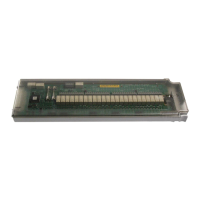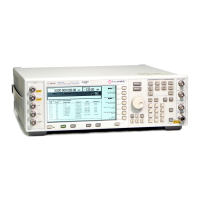1-104
Troubleshooting
RF Path Description (Frequency Generation, Level Control, and Modulation)
the A30 Modulation Filter (in analog models) or to the 3 to 20 GHz I/Q Modulator (in vector
models).
A6 Frac–N
The A6 Frac–N is part of the Synthesis Loop and the RF lowband path.
The RF signal from the A29 20 GHz Doubler is amplified, filtered, divided (dividers generate RF
output frequencies below 3.2 GHz), and then amplified again before being routed to the A8 Output.
The A8 Output provides the A6 Frac–N a pre-level bias voltage to maintain the required RF output
level to the A8 Output assembly.
Troubleshooting note: To check the A6 Frac–N RF output level, remove the A8 Output from the
signal generator while the signal generator is powered on. If the A8 Output is removed while the
power is on, the pre-level bias is maintained on the A6 Frac–N, maintaining the RF power level on
the A6 Frac–N output.
A8 Output
Analog
The A8 Output is in the RF lowband path; it provides:
• pre-level bias voltage to the RF output level control on the A6 Frac–N
For frequencies up to 3.2 GHz, the ALC diode controls the RF output power level. Without bias
applied to the ALC diode, the output power goes to the maximum level. In closed-loop operation,
the A10 ALC uses a negative voltage from both the A23 (< 2 GHz) and A24/25 (>2 GHz)
coupler/detectors to control the ALC diode’s bias.
•pulse modulation
Pulse modulation (RF pulsed on) is achieved by applying +5 Vdc to the pulse circuitry on the A8
Output. +5 Vdc turns the RF signal on; removing the +5Vdc turns the RF signal off. In
instruments without modulation capability that do not have the A11 Pulse/Analog Modulation
Generator installed, circuitry on the A8 Output and A30 Modulation Filter biases the pulse
diodes on.
• amplitude modulation
• the circuitry to generate under-range frequencies (<250 kHz)
Under-range frequencies are the result of mixing the A6 Frac–N RF signal with a 1 GHz signal
from the A7 Reference and using the difference between the two signals for the output. The A8
Output signal passes through the A23 Lowband Coupler/Detector to the A30 Modulation Filter.
Digital
In addition to providing the analog functionality described above, the A8 Output assembly used in
vector models contains an I/Q modulator that is driven with signals from the A13 I/Q Multiplexer to
provide I/Q modulation <3.2 GHz. When digital modulation is not selected, the I/Q modulator is
bypassed.

